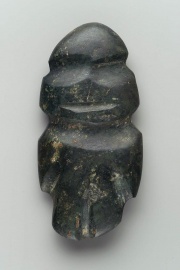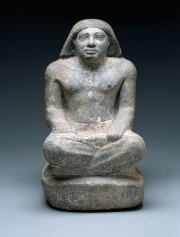Difference between revisions of "Diorite"
Jump to navigation
Jump to search
(username removed) |
|||
| (2 intermediate revisions by 2 users not shown) | |||
| Line 1: | Line 1: | ||
| − | [[File:1974.599-SC31008.jpg|thumb|]] | + | [[File:1974.599-SC31008.jpg|thumb|Diorite effigy<br>MFA# 1974.599]] |
== Description == | == Description == | ||
| − | A hard, coarse-grain, black-and-white speckled, granite-like igneous rock. Diorite is composed of [ | + | A hard, coarse-grain, black-and-white speckled, granite-like igneous rock. Diorite is composed of [[plagioclase]] feldspar mixed with [[hornblende]], [[biotite]], and/or [[augite]]. Small amounts of [[orthoclase]] or [[quartz]] may be present. Diorite was valued by the Egyptians and Sumerians for statuary and is presently used in building construction. Sources of diorite include Italy (Sondrio), Germany (Thuringia, Sassonia), Finland, Romania, Sweden, Scotland, and the US (Minnesota). |
| + | |||
| + | [[File:31.776-E7182CR-d1.jpg|thumb|Granodiorite statue<br>MFA# 31.776]] | ||
| − | |||
== Synonyms and Related Terms == | == Synonyms and Related Terms == | ||
green stone; trap rock; diorita (Esp.); diorite (Fr.); diorito (Port.); Diorit (Deut.); dioriet (Ned.) | green stone; trap rock; diorita (Esp.); diorite (Fr.); diorito (Port.); Diorit (Deut.); dioriet (Ned.) | ||
| − | == | + | == Physical and Chemical Properties == |
Takes a good polish | Takes a good polish | ||
| Line 30: | Line 31: | ||
</gallery> | </gallery> | ||
| + | ==Resources and Citations== | ||
| − | + | * ''Encyclopedia Britannica'', http://www.britannica.com Comment: "diorite" [Accessed January 22, 2002 | |
| − | |||
| − | * ''Encyclopedia Britannica'', http://www.britannica.com Comment: "diorite" | ||
* C.W.Chesterman, K.E.Lowe, ''Audubon Society Field Guide to North American Rocks and Minerals'', Alfred A. Knopf, New York, 1979 | * C.W.Chesterman, K.E.Lowe, ''Audubon Society Field Guide to North American Rocks and Minerals'', Alfred A. Knopf, New York, 1979 | ||
| − | * Wikipedia | + | * Wikipedia: http://en.wikipedia.org/wiki/Diorite (Accessed Nov. 2, 2005) |
* ''Van Nostrand's Scientific Encyclopedia'', Douglas M. Considine (ed.), Van Nostrand Reinhold, New York, 1976 | * ''Van Nostrand's Scientific Encyclopedia'', Douglas M. Considine (ed.), Van Nostrand Reinhold, New York, 1976 | ||
Latest revision as of 10:10, 29 August 2020
Description
A hard, coarse-grain, black-and-white speckled, granite-like igneous rock. Diorite is composed of Plagioclase feldspar mixed with Hornblende, Biotite, and/or Augite. Small amounts of Orthoclase or Quartz may be present. Diorite was valued by the Egyptians and Sumerians for statuary and is presently used in building construction. Sources of diorite include Italy (Sondrio), Germany (Thuringia, Sassonia), Finland, Romania, Sweden, Scotland, and the US (Minnesota).
Synonyms and Related Terms
green stone; trap rock; diorita (Esp.); diorite (Fr.); diorito (Port.); Diorit (Deut.); dioriet (Ned.)
Physical and Chemical Properties
Takes a good polish
| Composition | C4H8O2 |
|---|---|
| Mohs Hardness | 5.5 - 6.0 |
Additional Images
Resources and Citations
- Encyclopedia Britannica, http://www.britannica.com Comment: "diorite" [Accessed January 22, 2002
- C.W.Chesterman, K.E.Lowe, Audubon Society Field Guide to North American Rocks and Minerals, Alfred A. Knopf, New York, 1979
- Wikipedia: http://en.wikipedia.org/wiki/Diorite (Accessed Nov. 2, 2005)
- Van Nostrand's Scientific Encyclopedia, Douglas M. Considine (ed.), Van Nostrand Reinhold, New York, 1976
- Dictionary of Building Preservation, Ward Bucher, ed., John Wiley & Sons, Inc., New York City, 1996
- George Savage, Art and Antique Restorer's Handbook, Rockliff Publishing Corp, London, 1954




